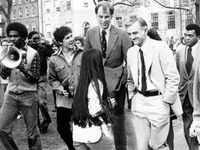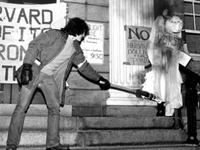On a cool April evening in 1978, more than 3,500 students took to the streets of Cambridge to protest the Harvard Corporation’s decision to reject student demands that the University divest itself of holdings in companies operating in South Africa.
Chanting “1-2-3-4, throw apartheid out the door; 2-4-6-8, don’t support the racist state,” thousands of demonstrators carried candles and kerosene-soaked torches as they marched from Harvard Yard to the Quad and along the Charles River.
Organized by the Southern Africa Solidarity Committee (SASC) in conjunction with the United Front—a coalition of seven campus anti-apartheid groups—the march was the culmination of months of student unrest over Harvard’s holdings in firms doing business in the country.
Events leading up to the march included the signing of a campus-wide divestment petition by more than 3,000, myriad meetings of the Harvard Corporation’s Advisory Committee on Shareholder Responsibility (ACSR), two open hearings and several Corporation meetings.
By the end of the academic year, the Corporation had condemned South Africa’s apartheid system as “repugnant and inhumane” and put in place a system of guidelines for investment in the country. These rules called for the University to use its proxy votes to urge companies operating in South Africa to “take active steps to oppose apartheid” and to stop investing in banks that granted loans to the South African government.
But The Corporation ruled out complete divestment as a “relatively ineffective means of pursuing ethical ends.”
That decision outraged members of the United Front, who called it “a kick in the teeth, a slap in the face,” and laid the groundwork for a conflict which would last well into the early 1980s.
The events of 1978 mark the beginning of what would become a general reluctance on the part of University administrators to use divestment as a means for expressing political or moral views.
Charles P. Slichter ’45, who was a member of the Corporation at the time, says the University’s actions in 1978 set a precedent for the way it would handle future divestment movements.
“Every decision you make becomes part of a record of thinking,” Slichter says.
A Hard-Fought Battle
Student activism on divestment at Harvard began to take shape in the early 1970s.
In 1972, 34 members of the Pan-African Liberation Movement staged a take-over of Mass. Hall, demanding that the University sell its investments in the Gulf Oil Corporation, which they alleged was supporting the Portuguese colonial regime in Angola at that time.
This Mass. Hall takeover marked the opening tussle in the fight for divestment and led to the creation of ACSR, a committee composed of four students, four faculty members and four alumni whose purpose was to advise the Corporation on the social and political implications of its investment policies.
Following a mid-decade lull, Harvard took up the issue of South African divestment in 1977 with the formation of the SASC, which moved divestment to the forefront of student activists’ agenda.
Read more in News
Pataki: 'Yale is Going to Crush Harvard'















